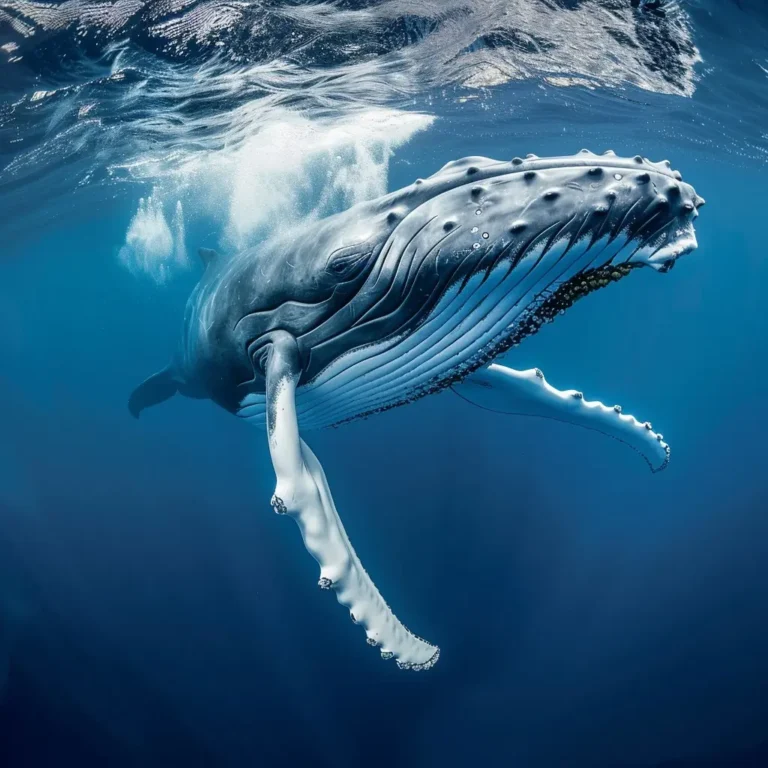Fun facts about whales that will make you whale with excitement! 🐋🌊 Discover the immense and intriguing world of these gentle giants as you learn about their incredible size, communication skills, and migration patterns.
From the heart that’s as big as a small car to songs that travel across oceans, whales are packed with astonishing details that will captivate your imagination. Dive in and uncover the majestic secrets of these magnificent marine mammals!
Interested in other animal’s facts, check out our curated list for more fun facts about animals.

Facts about Whales
1. Blue whales are the largest animals to have ever lived on Earth.
Blue whales can grow up to 100 feet (30 meters) long and weigh as much as 200 tons (approximately 181 metric tonnes). Their heart can weigh as much as a small car, and they consume around 4 tons of krill daily during feeding season. This immense size is supported by their diet, which consists almost entirely of tiny shrimp-like animals called krill.
2. Sperm whales have the biggest brains of any animal on Earth.
Sperm whales possess the largest brain of any animal, weighing about 18 pounds (8 kilograms). Their large brains are associated with their complex social structures and behaviors, including sophisticated communication methods and problem-solving abilities.
3. Humpback whale tails are as unique as human fingerprints.
The underside of a humpback whale’s tail has distinctive patterns that allow researchers to identify individual whales. This identification method is crucial for studying their migration patterns, social structures, and population dynamics.
4. Whales can store oxygen molecules in their bodies.
Whales have a high lung capacity and can store oxygen efficiently, allowing them to dive deep for extended periods. For example, sperm whales can hold their breath for up to 90 minutes while hunting for squid in the deep ocean.
5. Gray whales can travel over 14,000 miles round trip during migration.
Gray whales undertake one of the longest migrations of any mammal, traveling from their feeding grounds in the Arctic to breeding lagoons in Mexico and back. This journey can cover more than 14,000 miles (22,530 kilometers) annually.
6. Whales communicate through sound.
Whales use a variety of sounds to communicate, including moans, grunts, and songs. Humpback whales are particularly known for their complex songs, which can last up to 20 minutes and be heard miles away. These vocalizations play a role in mating and social interactions.
7. Sperm whales sleep standing up.
Sperm whales are known to sleep vertically in the water, with their tails dangling down. This position allows them to breathe easily through their blowholes while resting. They can switch off one hemisphere of their brain to stay alert for predators.
8. Whales can last for up to 20 minutes without breathing.
Some whale species, like the sperm whale, can hold their breath for extended periods, allowing them to dive deep in search of prey. Their ability to slow their heart rate and use oxygen efficiently enables them to stay submerged for long durations.
9. Whales have multiple stomachs.
Some whale species, such as the Baird’s whale, can have up to 13 stomachs. This adaptation helps them efficiently digest the tough, fibrous squid they consume. The extra stomachs also serve a dual purpose for female sperm whales, functioning as birthing chambers for their calves.
10. Whales make the longest migration of any mammal.
Many whale species migrate annually between warm waters for breeding and cold waters for feeding. The most impressive migrations are by humpback and gray whales, which travel thousands of miles between the tropics and polar seas each year.
11. The narwhal is known as the “unicorn of the sea.”
Male narwhals possess a long, spiral tusk that can grow up to 10 feet (3 meters) long. This tusk is actually an elongated tooth and is thought to play a role in social interactions and mating displays.
12. Beluga whales are sometimes called “sea canaries.”
Beluga whales are known for their vocalizations, which include whistles, clicks, and chirps. Their ability to produce a wide range of sounds has earned them the nickname “canaries of the sea.”
13. The fin whale is the second-largest animal on Earth.
Fin whales can grow up to 85 feet (26 meters) long and weigh up to 80 tons. They are known for their speed and agility, reaching speeds of up to 30 miles per hour (48 km/h).
14. The bowhead whale can live for over 200 years.
Bowhead whales are among the longest-lived mammals, with some individuals estimated to be over 200 years old. This longevity is partly attributed to their cold Arctic habitat, which may slow their metabolism.
15. Humpback whales are known for their acrobatic displays.
Humpback whales often breach, slap the water with their fins, and perform tail slaps as part of their behavior. These displays are thought to be a form of communication and may also serve to dislodge parasites.
16. The killer whale, or orca, is actually a type of dolphin.
Despite its name, the killer whale is the largest member of the dolphin family (Delphinidae). Orcas are highly social animals that live in family groups called pods, displaying complex social structures and behaviors.
17. The blue whale’s heart is the size of a small car.
The heart of a blue whale can weigh around 1,000 pounds (450 kg) and is capable of pumping 60 gallons (227 liters) of blood with each heartbeat. This immense organ is crucial for supporting the whale’s massive size.
18. Whales can hear sounds over long distances.
Whales have excellent hearing and can detect sounds from miles away. Their ability to hear low-frequency sounds helps them communicate and navigate in the vast ocean.
19. The humpback whale’s song can change over time.
Humpback whales are known for their complex songs, which can evolve over time. Researchers have observed that songs can change and spread through populations, similar to trends in human music.
20. The right whale is one of the most endangered whale species.
North Atlantic right whales are critically endangered, with fewer than 350 individuals remaining. Conservation efforts are crucial to protect this species from threats such as ship strikes and entanglement in fishing gear.
21. The bowhead whale has the largest mouth of any animal.
Bowhead whales have a massive mouth that can measure up to 14 feet (4.3 meters) wide. This adaptation allows them to filter-feed on small organisms in the water.
22. The sperm whale’s head is one-third of its body length.
The sperm whale has a distinctive block-shaped head that houses the spermaceti organ, which is used for echolocation and buoyancy control.
23. Whales have a layer of blubber for insulation.
Whales have a thick layer of blubber that helps insulate them from cold water temperatures. This fat layer can be several inches thick and also serves as an energy reserve.
24. The North Atlantic right whale is known for its callosities.
These rough patches of skin on the heads of North Atlantic right whales are unique to each individual and serve as a way for researchers to identify them.
25. The minke whale is the smallest baleen whale.
Minke whales can grow up to 30 feet (9 meters) long and are known for their speed and agility. They are often seen in coastal waters and are one of the most commonly sighted baleen whales.
26. The humpback whale’s flippers can be up to one-third of its body length.
Humpback whales have long, flexible flippers that can measure up to 15 feet (4.6 meters) in length. These flippers help them maneuver in the water and are covered in tubercles, which enhance their hydrodynamics.
27. Whales can dive to extreme depths.
The Cuvier’s beaked whale holds the record for the deepest dive of any cetacean, reaching depths of 2.99 miles (4,500 meters) and staying submerged for over 2 hours.
28. The gray whale migrates between feeding and breeding grounds.
Gray whales undertake a remarkable migration from the cold feeding grounds in the Arctic to warm breeding lagoons in Mexico, covering distances of up to 10,000 miles (16,000 kilometers).
29. The sperm whale’s echolocation is highly developed.
Sperm whales use echolocation to locate prey in the dark depths of the ocean. They emit clicks that bounce off objects, allowing them to “see” their surroundings through sound.
30. The bowhead whale’s baleen plates can measure up to 14 feet (4.3 meters) long.
These plates are used to filter small organisms from the water, allowing bowhead whales to feed efficiently in their Arctic habitat.
31. Whales can produce sounds at varying frequencies.
Different species of whales produce sounds at different frequencies, with some capable of producing low-frequency calls that can travel long distances underwater.
32. The beluga whale can swim backward.
Belugas have a flexible neck that allows them to turn their heads and swim backward, a unique ability among whale species.
33. The humpback whale’s song can last for up to 20 minutes.
Male humpback whales sing complex songs during the breeding season, which can be heard by other whales over long distances.
34. The fin whale is known as the “greyhound of the sea.”
Fin whales are one of the fastest whale species, capable of reaching speeds of up to 30 miles per hour (48 km/h).
35. The right whale is named for being the “right” whale to hunt.
Historically, right whales were targeted by whalers because they are slow-moving and float after being killed, making them easier to catch.
36. The sperm whale can dive deeper than any other whale.
Sperm whales are known to dive to depths of over 3,200 meters (10,500 feet) in search of squid and other deep-sea prey.
37. The orca is known for its complex social structures.
Orcas live in matrilineal pods, where family groups are led by older females. They exhibit strong social bonds and cooperative hunting strategies.
38. The bowhead whale can break through thick ice.
Bowhead whales have large, robust heads that allow them to break through sea ice, making them well-adapted to Arctic environments.
39. The baleen plates of some whales can filter out tiny prey.
Baleen whales, such as the humpback and blue whales, use their baleen plates to filter krill and small fish from the water, allowing them to feed efficiently.
40. Whales have a unique method of thermoregulation.
Their thick layer of blubber helps insulate them from cold water temperatures, while their large size reduces heat loss.
41. The right whale’s population is critically endangered.
Conservation efforts are underway to protect North Atlantic right whales, which face threats from ship strikes and fishing gear entanglement.
42. The gray whale’s migration is one of the longest of any mammal.
Gray whales migrate between feeding grounds in the Arctic and breeding lagoons in Mexico, covering distances of up to 10,000 miles (16,000 kilometers).
43. The humpback whale’s fluke is unique to each individual.
The patterns on the underside of a humpback whale’s fluke are distinct, allowing researchers to identify and track individual whales.
44. The sperm whale’s social structure is matrilineal.
Sperm whales live in family groups led by females, with strong social bonds and cooperative behaviors among members.
45. The beluga whale’s skin can change color.
Belugas can change their skin color from gray to white as they mature, which helps them blend into their icy Arctic habitats.
46. The blue whale’s heart can weigh as much as a small car.
The blue whale’s heart is the largest of any animal, weighing around 1,000 pounds (450 kg) and capable of pumping vast amounts of blood.
47. The killer whale is known for its intelligence.
Orcas exhibit complex behaviors, including cooperative hunting and the use of tools, showcasing their advanced cognitive abilities.
48. The humpback whale’s feeding technique called “bubble net feeding” is fascinating.
Humpback whales work together to create bubble nets to trap fish, allowing them to feed more effectively.
49. The bowhead whale has the thickest blubber of any whale species.
Bowhead whales have up to 18 inches (46 cm) of blubber, which provides insulation in frigid Arctic waters.
50. The fin whale’s dorsal fin can be up to 6 feet (1.8 meters) tall.
This distinctive dorsal fin helps identify fin whales and is a key feature used by researchers in the field.
51. The narwhal’s tusk is a sensory organ.
Recent studies suggest that the narwhal’s tusk may function as a sensory organ, helping them detect changes in their environment.
52. The humpback whale’s song can evolve over time.
Humpback whales’ songs change from year to year, with new themes emerging and spreading among populations.
53. The gray whale’s skin is covered in barnacles.
Barnacles often attach themselves to gray whales, creating a unique ecosystem on their skin.
54. The sperm whale’s echolocation is highly developed.
Sperm whales use clicks and clicks to navigate and hunt in the dark depths of the ocean.
55. The bowhead whale can live for over 200 years.
Bowhead whales are among the longest-lived mammals, with some individuals estimated to be over 200 years old.
56. The blue whale’s feeding strategy involves gulping massive amounts of water.
Blue whales take in large gulps of water filled with krill, then use their baleen plates to filter out the food.
57. The killer whale is known for its diverse diet.
Orcas are apex predators and have a varied diet that can include fish, seals, and even other whales.
58. The beluga whale can swim backwards.
Belugas have a unique ability to swim backwards, which is rare among whale species.
59. The humpback whale’s flippers are covered in tubercles.
These small bumps on their flippers help improve their hydrodynamics, allowing for better maneuverability in the water.
60. Whales play a crucial role in the marine ecosystem.
Whales contribute to nutrient cycling in the ocean, and their waste products help fertilize phytoplankton, which forms the base of the marine food web.
References
- NOAA Fisheries. (n.d.). 10 Wonderful Whale Facts. Retrieved from NOAA Fisheries
- National Geographic. (n.d.). Blue Whale. Retrieved from National Geographic
- Greenpeace. (n.d.). Whale Facts: 11 Fascinating Things to Know. Retrieved from Greenpeace
- Ocean Conservancy. (n.d.). Fun Facts About Whales. Retrieved from Ocean Conservancy
- Whale and Dolphin Conservation. (n.d.). Amazing Facts About Whales. Retrieved from WDC
- Smithsonian National Museum of Natural History. (n.d.). Whale Facts. Retrieved from Smithsonian
- Marine Conservation Society. (n.d.). Fun Facts About Marine Life. Retrieved from MCS
- SeaWorld. (n.d.). Amazing Ocean Animal Facts. Retrieved from SeaWorld
- Ocean Exploration Trust. (n.d.). Fun Facts About Ocean Animals. Retrieved from Ocean Exploration Trust
- National Ocean Service. (n.d.). What is a Whale? Retrieved from NOAA Ocean Service






